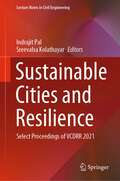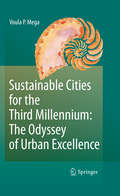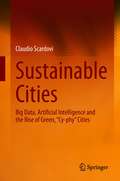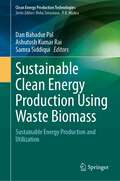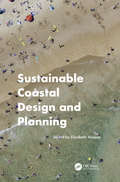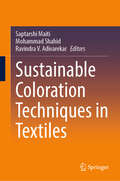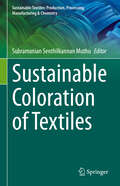- Table View
- List View
Sustainable Catalysis: Challenges and Practices for the Pharmaceutical and Fine Chemical Industries
by Peter J. Dunn Michael J. Krische Michael T. Williams K. K. Mimi HiiOpens the door to the sustainable production of pharmaceuticals and fine chemicals Driven by both public demand and government regulations, pharmaceutical and fine chemical manufacturers are increasingly seeking to replace stoichiometric reagents used in synthetic transformations with catalytic routes in order to develop greener, safer, and more cost-effective chemical processes. This book supports the discovery, development, and implementation of new catalytic methodologies on a process scale, opening the door to the sustainable production of pharmaceuticals and fine chemicals. Pairing contributions from leading academic and industrial researchers, Sustainable Catalysis focuses on key areas that are particularly important for the fine chemical and pharmaceutical industries, including chemo-, bio-, and organo-catalytic approaches to C–H, C–N, and C–C bond-forming reactions. Chapters include academic overviews of current innovations and industrial case studies at the process scale, providing new insights into green catalytic methodologies from proof-of-concept to their applications in the synthesis of target organic molecules. Sustainable Catalysis provides the foundation needed to develop sustainable green synthetic procedures, with coverage of such emerging topics as: Catalytic reduction of amides avoiding LiAlH4 or B2H6 Synthesis of chiral amines using transaminases Industrial applications of boric acid and boronic acid catalyzed direct amidation reactions C–H activation of heteroaromatics Organocatalysis for asymmetric synthesis Offering a balanced perspective on current limitations, challenges, and solutions, Sustainable Catalysis is recommended for synthetic organic chemists seeking to develop new methodologies and for industrial chemists dedicated to large-scale process development.
Sustainable Chemical, Mineral and Material Processing: Select proceedings of 74th Annual Session of Indian Institute of Chemical Engineers (CHEMCON-2021) (Lecture Notes in Mechanical Engineering)
by Suddhasatwa Basu Eswaraiah Chinthapudi Bhaskar Narayan ThoratThis book presents select proceedings of the Indian Chemical Engineering Congress (CHEMCON-2021) under the theme "Sustainable Utilization of Resources for Chemical Mineral Sectors". It covers broad topics such as chemical reaction and processes, material science and engineering, coal and mineral processing, pyro- and hydro-metallurgical processes, environmental engineering and waste management, advanced engineering, and energy materials. This book is useful for the researchers, professionals, and policymakers interested in sustainable utilization of chemical and mineral resources.
Sustainable Cities Reimagined: Multidimensional Assessment and Smart Solutions
by Stanislav ShmelevTo assess urban sustainability performance, this book explores several clusters of cities, including megacities, cities of the Global South, European and North American cities, cities of the Middle East and North Africa, cities of Central and South East Asia, a city state of Singapore and a large group of global cities. It applies a multi-criteria approach using a panel of environmental, economic, social and smart indicators to assess progress and policies in global cities including London, New York, Hong Kong, San Francisco, Los Angeles, São Paolo, Rio de Janeiro, Buenos Aires, Paris, Berlin, Stockholm, Moscow, Beijing, Seoul, Singapore, Shanghai, Sydney, Tokyo and many others. Additional attention is given to the issues of climate change, poverty and smart dimensions, with renewable energy and the drivers of urban CO2 emissions playing the central role. This book is abundant with case studies considering strategies, policies and performance of the leading cities, including San Francisco, Stockholm and Seoul in greater depth, exploring how their successes can be used by other cities. The book identifies key linkages between different smart and sustainability dimensions as well as investment opportunities in cities with sustainability potential. This book will be of great interest to policy makers, city and regional authorities as well as scholars and students of urban planning and sustainable development aiming to facilitate a sustainability transition in our cities around the world.
Sustainable Cities and Resilience: Select Proceedings of VCDRR 2021 (Lecture Notes in Civil Engineering #183)
by Indrajit Pal Sreevalsa KolathayarThis book presents the select proceedings of the Virtual Conference on Disaster Risk Reduction (VCDRR 2021). It provides insights on urban resilience and sustainable infrastructure. All the chapters in this volume are segregated into five clusters, e.g., Resilient infrastructure in construction, Innovative construction interventions, Waste Management and Disaster Risk Reduction, Urban Development and Sustainability, and Cross-cutting issues. Various topics covered in this book are risk assessment, prevention, mitigation, preparedness and response, renewable energy, waste management, resilient cities, and environmental management. This book is a comprehensive volume on disaster risk reduction (DRR) and its management for a sustainable built environment. This book will be useful for the students, researchers, policy makers and professionals working in the area of civil engineering, especially disaster management.
Sustainable Cities for the Third Millennium: The Odyssey of Urban Excellence
by Voula P. MegaThis book offers a 360 degree view of the challenges facing cities at the dawn of the millennium in terms of growth, governance, institutions and infrastructures, environmental well-being, social integration, science, culture and the arts, urban renaissance and planning, local democracy and citizenship. One year afte the crisis that started in 2008, the book presents responses to overcome the crisis of values and engage in a sustainability path from European and world cities.
Sustainable Cities: Big Data, Artificial Intelligence and the Rise of Green, “Cy-phy” Cities
by Claudio ScardoviGlobal cities are facing an almost unprecedented challenge of change. As they re-emerge from the Covid 19 pandemic and get ready to face climate change and other, potentially existential threats, they need to look for new ways to support wealth and wellbeing creation – leveraging Big Data and AI and suing them into their physical reality and to become greener, more inclusive and resilient, hence sustainable.This book describes how new digital technologies could be used to design digital and physical twins of cities that are able to feed into each other to optimize their working and ability to create new wealth and wellbeing. The book also describes how to increase cities’ social and economic resilience during crisis time and addressing their almost fatal weaknesses – as it became all too obvious during the recent COVID 19 crisis. Also, the book presents a framework for a critical discussion of the concept of “smart-city”, suggesting its development into a “cyber” and “meta” one – meaning, not only digital systems can allow physical ones (e.g. cities, citizens, households and companies) to become “smarter”, but also the vice versa is true, as off line data and real life behaviours can support the optimization and development of virtual brains as a sum of big data and artificial intelligence apps all sitting “over the cloud”. An analysis of the fundamental dynamics of this emerging “info-telligence” economy, and of the potential role of big digital players like Amazon, Google and Facebook is then paving the way to discuss a few strategic forays on how traditional sectors such as financial services, real estate, TMT or health could also evolve, leveraging Big Data and AI in a cyber-physical integrated setting. Finally, a number of thought provoking use cases that could be designed around individuals, and to improve the success and the resilience of households and companies living and working in urban areas are discussed, as an example of one of the most exciting future markets to come: the one of global, sustainable cities
Sustainable Cities: Pioneering Approaches to Green Urbanism and Climate Resilience (Advances in Science, Technology & Innovation)
by Simon Elias Bibri Giuseppe Resta Dorina Papa Dina MagnayeThe book studies specific aspects of urban planning and environmental management, aiming to provide actionable insights and solutions. This book opens with an analysis of urban processes and the development of mass housing estates, using Famagusta, Cyprus, as a case study. It highlights how topographical factors influence urban growth and housing patterns, providing important implications for infrastructure planning. A significant focus is placed on the development of environmentally-friendly building materials. Several chapters explore the use of waste products, such as cork, in creating sustainable materials. Green and blue infrastructure also receive substantial attention. The book addresses strategies for integrating these elements into urban environments to combat climate change. Topics such as the retention capacity of green roofs and the role of vegetation in improving urban air quality underscore the importance of ecological infrastructure in creating resilient cities. The book further studies urban climate and pollution analysis, presenting advanced methods for monitoring and managing environmental conditions. Chapters on climate change monitoring, air pollution assessment through bryophytes, and VOCs monitoring provide tools for understanding and addressing urban environmental challenges. Human-centric design is another key theme, with discussions on pedestrian comfort and walkability in urban spaces. By focusing on outdoor promenades and thermal comfort, the book highlights the need for urban designs that enhance the quality of life for residents. Practical approaches to project management and planning are also covered. The book introduces methodologies such as PERT/CPM and Monte Carlo simulation techniques for improving project outcomes and developing criteria for climate-friendly planning competitions. Finally, the preservation of landscape heritage amidst urban expansion is explored. A methodology for creating a landscape catalog in Arequipa, Peru, is presented as a way to balance development with the conservation of cultural and natural landscapes.
Sustainable Civil Engineering Practices: Select Proceedings of ICSCEP 2019 (Lecture Notes in Civil Engineering #72)
by Sanjay Kumar Shukla Varinder S. KanwarThis book comprises select proceedings of the International Conference on Sustainable Civil Engineering Practices (ICSCEP 2019). It covers several important aspects of sustainable civil engineering practices dealing with effective waste and material management, natural resources, industrial products, energy, food, transportation and shelter, while conserving and protecting the environmental quality and the natural resource base essential for future development. The book also discusses engineering solutions to sustainable development and green design issues. Special emphasis is given on qualitative guidelines for generation, treatment, handling, transport, disposal and recycling of wastes. The book is intended as a practice-oriented reference guide for researchers and practitioners, and will be useful for all working in sustainable civil engineering related fields.
Sustainable Clean Energy Production Using Waste Biomass: Sustainable Energy Production and Utilization (Clean Energy Production Technologies)
by Dan Bahadur Pal Ashutosh Kumar Rai Samra SiddiquiThis edited volume covers sustainable biomass valorization and its application in various sectors.Bioenergy has concerned enormous attention as a promising alternative to conventional energy resources. Abundance of bioresources and their renewable nature provides a distinct advantage to biofuels from sustainability perspective. Biofuels have found increasing applications in the energy and transportation sector in recent years. Blended fuels are being used worldwide. However, several challenges remain to be addressed due to the diverse nature of biomasses and inherent recalcitrant nature of biological materials used as feedstock. This book aims to provide an overview of recent developments in the production of bioenergy and its applications in various areas. Specific emphasis is given to production of biofuels from modern biomass such as agro-forest waste and dedicated non-edible energy crops that do not interfere with food production. The scope of the book covers synthesis and characterization of biologically derived fuels, advances in microbiological methods and enzyme engineering approaches. The book covers techno-economic analysis to identify challenges and prospects for commercialization of biofuels. The directions for future research should pave way for net zero scenario for a sustainable world.The book will cater to a wide range of readers interested in learning the fundamentals as well as advances in the field of biofuels.
Sustainable Climate Action and Water Management (Advances in Geographical and Environmental Sciences)
by Ram Kumar Mishra R. B. Singh Anupama DubeyThis book discusses various issues relating to water resources, climate change and sustainable development. Water is the main driving force behind three major pillars of sustainable development: environmental, social and economic. As stated in the United Nations Sustainable Development Goals, development of these pillars rests on the availability and management of resources to fulfill the demand for water. By identifying the various challenges in the context of water resources and climate change, the book offers insights into achieving a better and more sustainable future. It provides a unique forum for practitioners and academics to exchange ideas on emerging issues, approaches, and practices in the area of water resources, climate change, and sustainability, while also presenting valuable information for policymakers on the changing contours of water management and climate change mitigation. As such it is a useful resource for decision-makers at the local as well as the global level.
Sustainable Coastal Design and Planning
by Elizabeth MossopAs different parts of the globe deal with the challenges of coastal settlements in the Anthropcene landscape of increasing uncertainty, the methods of design offer new strategies for developing and testing solutions. These complex problems require collaboration across disciplines, with scientists, planners, engineers, designers, and others able to work together in finding new ways of living in coastal and changing landscapes. Sustainable Coastal Design and Planning is an outstanding collection of essays by leading practitioners and academics from across the globe on design and planning for coastal resilience in the face of climate change. It thoroughly explores the questions of coastal change at different scales and provides international case studies that illustrate diverse strategies in different geographies and cultures. Taken as a whole, they canvas a broad palette of approaches and techniques for engaging these complex problems. Divided in two parts, this book focuses on how to develop solutions through multidisciplinary design thinking and informs all stakeholders on specific methods and practices that will be needed to work effectively in this dynamic space.
Sustainable Coloration Techniques in Textiles
by Mohammad Shahid Ravindra V. Adivarekar Saptarshi MaitiThis book highlights advanced sustainable techniques and innovations in textile coloration. It begins with an extensive overview of sustainability issues in textile dyeing, addressing environmental and ethical challenges. The book explores cutting-edge advancements in coloration machinery and process enhancements, offering innovative solutions for pre-treatment and dyeing processes. It presents waterless dyeing as a sustainable alternative to conventional wet processing and discusses solvent-based dyeing trends and their eco-conscious applications. Emerging technologies like ultrasound-assisted dyeing, electrochemical dyeing, and supercritical-fluid technology are examined for their efficiency, performance, and environmental advantages. The book also covers sustainable techniques such as salt-free dyeing and micelle dyeing using green chemistry principles. Additionally, it explores bio-derived dyes and mordants, highlighting their role in greener textile coloration, and introduces biosurfactants as eco-friendly substitutes to synthetic auxiliaries in wet processing. The book concludes with exploring recent advances in sustainable textile printing techniques. Catering to researchers, students, and industry professionals, this comprehensive reference offers innovative solutions to address sustainability challenges in the textile sector.
Sustainable Coloration of Textiles (Sustainable Textiles: Production, Processing, Manufacturing & Chemistry)
by Subramanian Senthilkannan MuthuThis volume provides a variety of cases on sustainable coloration of textiles. It offers valuable insights and solutions to reduce the environmental impact of textile dyeing and pollution due to extensive use of water, energy, and toxic chemicals. The cases presented in this book offer sustainable innovations and strategies to mitigate the impacts of textile coloration. This work will serve as an essential resource for students, educators, and practitioners looking to understand and implement sustainable practices in textile production.
Sustainable Communities
by Woodrow W. Clark IIThe book starts with a discussion of global warming and climate change. The problem is well documented. Part One gives background for sustainable developments and gives studies of proven, substantiated and documented solutions. The time to act has begun. The "Green Revolution" has begun. Some authors call it The Third Industrial Revolution (Rifkin, 2005) since in the 21st century the industrially developed world has begun to move rapidly from fossil fuels (The Second Industrial Revolution) to renewable energy generation, storage technologies, and sustainable communities. Now is the time to understand and learn the tools that make sustainable communities of all kinds real. The book provides a vast, but not the total, amount of materials and data. The intent is to give students of sustainable development some well-established resources and tools. By 2008, the concept of "Green" had been so much in marketing and product services that it lost its meaning. The "branding" of green meant a whole new industrial sector suddenly emerged globally. However, the proof that there is both a Green Revolution and actual solutions to global warming must be seen in those sustainable communities who have existed, grown or developed using tested tools for sustainability. One of the key tools is the concern for conservation of natural resources, energy efficiency and the use of renewable energy systems (solar, wind, geothermal and bio-mass among others) along with storage devices for power generation. Communities in Europe and Asia have lead the way historically. The book presents actual cases of sustainable communities. The case of Frederikshavn in Denmark (Chapter # 6) clearly illustrates how small towns and villages can be sustainable. Far more intuitive and with common sense, Dos Lagos in California (Chapter #4) demonstrates how concern for the natural environment can create a mix-use community of homes, shops, offices and a golf course. Far more planned and strategic are the nine college campuses of the Los Angeles Community College District (Chapter #3) who recognized that public policy and that sector must lead the private sector by example as well as by proving the tools and economics of sustainable communities. And the private sector took note. A number of private companies from Safeway with its 20+ energy independent storage facilities to Toyota with Platinum LEED (Leadership in Environment and Energy Design) USA Headquarters in Torrance, California. Honda was not far behind with its "Green Hydrogen" Refueling station that electronizes solar energy into hydrogen for its hydrogen fuel cell cars. The Green Revolution could be seen with the hybrid cars that lead Toyota to be the No #1 Auto maker. Part Two of the book reviews the tools needed to make sustainable communities anywhere in the world. The key one is the technology (s) from science and engineering (Chapter #8). All too often people do not know that there are environmentally sound technologies that exist today (Clark, 2000) to make communities sustainable. Then when the political leaders discover that the technologies exist they argue that the costs are too high. Not true. And certainly not true today as Chapter #9 clearly demonstrates. There is the need to rethink basic cost benefit analyses for goods and services as being in the short term (2-3 years) into life cycle analyses (1-20 years) along with triple bottom line benefits and externality economic impacts on health, pollution and the atmosphere. In the end sustainable communities must be just that: capable of producing and using their own resources. Global warming starts and can end locally. If they need resources from outside or a long distance away, then those needs must be environmentally sound in terms of the goods themselves. And especially they must be sustainable in terms of transportation and services. This local and global change means new paradigms and approaches in public policy, environmentally sound technologies, economics and systems must be implemented today. Such a sustainable ...
Sustainable Communities and the Challenge of Environmental Justice
by Julian AgyemanArgues that environmental justice and the sustainable communities movement are compatiblePopularized in the movies Erin Brockovich and A Civil Action, “environmental justice” refers to any local response to a threat against community health. In this book, Julian Agyeman argues that environmental justice and the sustainable communities movement are compatible in practical ways. Yet sustainability, which focuses on meeting our needs today while not compromising the ability of our successors to meet their needs, has not always partnered with the challenges of environmental justice.Sustainable Communities and the Challenge of Environmental Justice explores the ideological differences between these two groups and shows how they can work together. Agyeman provides concrete examples of potential model organizations that employ the types of strategies he advocates. This book is vital to the efforts of community organizers, policymakers, and everyone interested in a better environment and community health.
Sustainable Community Health: Systems and Practices in Diverse Settings
by Elias MpofuApplying a trans-disciplinary approach, this book provides a comprehensive, research-based guide to understanding, implementing, and strengthening sustainable community health in diverse international settings. By examining the interdependence of environmental, economic, public health, community wellbeing and development factors, the authors address the systemic factors impacting health disparities, inequality and social justice issues. The book analyzes strategies based on a partnership view of health, in which communities determine their health and wellness working alongside local, state and federal health agencies. Crucially, it demonstrates that communities are themselves health systems and their wellbeing capabilities affect the health of individuals and the collective alike. It identifies health indicators and tools that communities and policy makers can utilize to sustain truly inclusive health systems. This book offers a unique resource for researchers and practitioners working across psychology, mental health, rehabilitation, public health, epidemiology, social policy, healthcare and allied health.
Sustainable Community Movement Organizations: Solidarity Economies and Rhizomatic Practices (Routledge Focus on Environment and Sustainability)
by Francesca Forno Richard R. WeinerThis volume shines a light on Sustainable Community Movement Organizations (SCMOs), an emergent wave of non-hierarchical, community-based socio-economic movements, with alternative forms of consumption and production very much at their core. Extending beyond traditional ideas of cooperatives and mutualities, the essays in this collection explore new geographies of solidarity practices ranging from forms of horizontal democracy to interurban and transnational networks. The authors uniquely frame these movements within the Deleuzian concept of the ‘rhizome’, as a meshwork of alternative spaces, paths and trajectories. This connectivity is illustrated in case studies from around the world, ranging from protest movements in response to austerity measures in Southern Europe, to the Buen Vivir movement in the Andes, and Rotating Savings and Credit Associations (ROSCAs) in the Caribbean and Canada. Positioning these cases in relation to current theoretical debates on Social Solidarity Economy, the authors specifically address the question of the persistence and the durability of the organizing practices in community economies. This book will be a valuable tool for academics and students of sustainable consumption, environmental policy, social policy, environmental economics, environmental management and sustainability studies more broadly.
Sustainable Consumption: The Right to a Healthy Environment
by Lucila De Almeida Alberto do Amaral Junior Luciane Klein VieiraThis book provides a broad understanding of whether law plays a role in influencing patterns of sustainable consumption and, if so, how. Bringing together legal scholars from the Global South and the Global North, it examines these questions in the context of national, transnational and international law, within single and plural legal systems, and across a range of sector-specific issue areas.The chapters identify how traditional legal disciplines (e.g. constitutional law, consumer law, public procurement, international public law), sector-related regulation (e.g. energy, water, waste), and legal rules in specific areas (e.g. eco-labelling and packing) engage with the concept of sustainable consumption. A number of the contributions describe this relationship by isolating a national legal system, while others approach it from the vantage point of legal pluralism, exploring the conflicts and convergences of rules between multiple international treaties (or guidelines) and those between the rules of international and transnational law (or both) vis-à-vis national legal systems. While sustainable consumption is recognised as an important field of interdisciplinary research linking virtually all social science disciplines, legal scholarship, in contrast, has neglected the importance of the field of sustainable consumption to the law. This book fills the gap.
Sustainable Cosmeceuticals: Integrating Natural and Biotechnological Innovations
by Muhammad Arshad Sadia Javed Shazia AbrarThis book explores eco-cosmeceuticals and offers a comprehensive overview of the latest sustainable and environmentally friendly innovations in cosmetic science. The book also addresses the pressing need for sustainable development in the beauty industry, aligning with global Sustainable Development Goals (SDGs). In this book, through scientific research and practical applications, readers will gain insights into how natural and eco-friendly ingredients are revolutionizing skincare and cosmetic products. Divided into 3 main parts, the chapters cover a wide array of topics, including the role of herbal extracts in achieving SDGs, sustainable cosmeceuticals using natural colorants from plants, and the potential of zooceuticals derived from animals. Readers will also discover groundbreaking research on cosmetics sourced from marine algae and mushrooms, as well as green biotechnological applications in aesthetic medicine. The book closes with a section dedicated to future trends and challenges, exploring cutting-edge technologies such as gene array technology and nanotechnology in skincare, while addressing critical issues like microbiological safety and cosmeceutical legislation, and providing a Life Cycle Assessment perspective in eco-cosmeceuticals. Given its breadth, this book is an essential resource for researchers, scholars, and practitioners in the fields of cosmetic science, biotechnology, and environmental sustainability. It invites readers to consider how these innovations can transform the future of beauty products, and it is particularly valuable for those interested in integrating eco-friendly practices into their work or studies.
Sustainable Crop Disease Management using Natural Products
by Kurucheve Vadivel Sangeetha Ganesan Jayaraj JayaramanAlternative methods of disease control such as natural products and compounds derived from biological origins, provide an effective alternate to the use of chemical products or a means to minimize their use. It is imperative now to look for such sustainable crop disease management approaches, that include routine and alternative methods. Natural products for sustainable crop disease management is an effort in this direction, and deals with immediate concerns in the field of natural and alternative products for disease control, apart from using biocontrol organisms. This book presents up-to-date information on natural products and compounds derived from biological origins and thoroughly discusses their applicability, field use and prospects for adoption under different cropping conditions. This book also validates disease management strategies.
Sustainable Crop Disease Management using Natural Products
by Kurucheve Vadivel Sangeetha Ganesan Jayaraj JayaramanAlternative methods of disease control such as natural products and compounds derived from biological origins, provide an effective alternate to the use of chemical products or a means to minimize their use. It is imperative now to look for such sustainable crop disease management approaches, that include routine and alternative methods. Natural products for sustainable crop disease management is an effort in this direction, and deals with immediate concerns in the field of natural and alternative products for disease control, apart from using biocontrol organisms. This book presents up-to-date information on natural products and compounds derived from biological origins and thoroughly discusses their applicability, field use and prospects for adoption under different cropping conditions. This book also validates disease management strategies.
Sustainable Crop Protection under Protected Cultivation
by P. Parvatha ReddyThis book focuses on pests (insect and mite) and diseases (fungal, bacterial, viral and nematode) in protected horticulture (fruits, vegetables and ornamentals) using physical, cultural, chemical, biological, host resistance, and integrated methods. It opens with chapters describing the setting in which integrated pest and disease control operates, i. e. , the greenhouse and its environment. Subsequent chapters present the basic strategies and tactics of different control methods including integrated control, with special reference to greenhouse crops. Further chapters include the different facets of biological pest and disease control - its scientific bases, its development in practice, its commercialization and quality control. The concluding chapters of the book highlight the present status of integrated pest and disease control for the most important greenhouse crops (fruits, vegetables and flower crops) worldwide. The book's final chapter explores future challenges for researchers assigned to identify non-pesticide methods and integrate sustainable pest management technologies that can contribute to increased productivity, such as breeding for durable resistance, biological control and devising integrated methods that will have minimal adverse environmental and social impacts. Among productivity-enhancing technologies, protected cultivation has a tremendous potential to increase the yield of vegetables and flower cro ps by several fold. Pests and diseases are one of the major challenges to protected cultivation. Year-round warm temperatures and relatively high humidity together with abundant food make the protected environment of greenhouses highly attractive to pests and diseases. Nevertheless, very little attention has been paid to the manipulation of greenhouse environments expressly to avoid disease epidemics and insect infestations, which together can easily account for 30% of crop losses. This book will be of immense value to all members of the scientific community involved in teaching, research and extension activities on protected horticulture. It also offers a useful reference guide for policymakers and practicing farmers, and can be used as a textbook for postgraduate courses.
Sustainable Design for Global Equilibrium
by Md. Faruque HossainThis book focuses on holistic approaches of applying sustainable practices in all sectors of building, infrastructure, and energy to achieve a best-balanced global energy, building, infrastructure, transportation, and water technology (EBITW) regime. It presents a series of solutions based on innovative research and applications for building a sustainable Earth for future generations. The goal of this book is to define the context of instigation for thinking through the scientific theories and practical applications of sustainability mechanisms to confirm a global equilibrium by the implementation of the following main practices: Sustainable Energy, Sustainable Architectural and Engineering Design Technology, Sustainable Environment and Society, and Sustainable Earth.
Sustainable Design for the Built Environment
by Rob Fleming Saglinda H Roberts Chitsanzo IsaacSustainable Design for the Built Environment marks the transition of sustainable design from a specialty service to the mainstream approach for creating a healthy and resilient built environment. This groundbreaking and transformative textbook introduces sustainable design in a clear, concise, easy-to-read format.This new edition includes fully updated exercises and online resources, an increased focus on diversity, equity, and inclusion in design, more international examples, perspectives, and approaches, enhanced full colour visuals, and additional resources for further study. The book takes the reader deep into the foundations of sustainable design, and creates a holistic and integrative approach addressing the social, cultural, ecological, and aesthetic aspects in addition to the typical performance-driven goals. The first section of this book is thematically structured around the origins, principles, and frameworks of sustainable design, aimed at inspiring a deeper, broader, and more inclusive view of sustainability. The second section examines strategies such as biophilia and biomimicry, adaptation and resilience, and health and well-being, including recent developments following the COVID-19 pandemic. The third section examines the application of sustainability principles from the global, urban, district and site, building, and human scales, illustrating how a systems thinking approach allows sustainable design to span varied contexts and multiple scales.This textbook is intended to inspire a new vision for the future that unites human activity with natural processes to form a regenerative, coevolutionary model for sustainable design. Supported by additional resources including additional reading for each chapter and classroom assignments, this book will be essential reading for students of sustainability and sustainable design.
Sustainable Design in Textiles and Fashion (Sustainable Textiles: Production, Processing, Manufacturing & Chemistry)
by Subramanian Senthilkannan Muthu Miguel Angel GardettiThis book highlights the Eco-design or Sustainable design in textiles and fashion, aimed at reducing their environmental impact throughout their life cycle. Sustainable design is one of the core elements practiced in various industrial sectors. The textiles and fashion sector, is also creating a huge environmental brunt in terms of various fibres, processes, consumption of various resources including dyes, chemicals and auxiliaries, etc,. Thus, sustainable design is the key to reduce the environmental impacts made out of textiles and fashion products. This book includes seven informative chapters to decipher the concept and applications of sustainable design in textiles and fashion.



